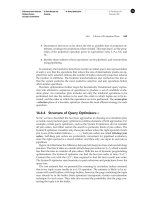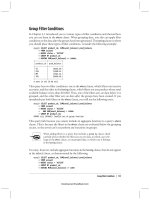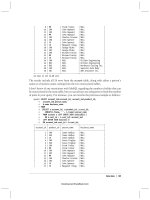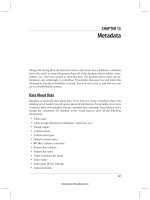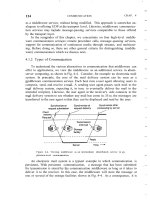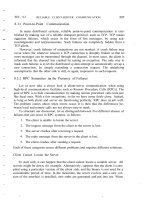head first java second edition phần 7 ppt
Bạn đang xem bản rút gọn của tài liệu. Xem và tải ngay bản đầy đủ của tài liệu tại đây (3.12 MB, 68 trang )
controller
events
import
javax
.sound.Ulidi.
*;
public
class
MiniMuaicPlayer2
public
static
void
main(String[]
args)
(
~n£MusicPlayer2
mini
: new
MiniMusicPlayar2();
mini-goO
;
Sequence
seq
= new
Sequence
(Sequence.
PPQ, 4) ;
Track
track
=
s&q.createTrack();
sequencer.setsequence(seq);
sequencer.setTempoInBPM(220};
sequencer.start()
;
}
catch
(Exception
ax)
II
close
(~
-I:h~
CO'I'tr
ol
1ty
-
L-
T'nL
~"ty\t
ha"cilty
"'~
~c:
t.,i
e 'fo/t.
~d
~e
~
.l \"
l_
i,,~-tat~.
1 I
"r.(
~ ,e""
'S""'
·. t. KIl to the
tD",,,,a,,a-
,
e ,e"t"
'/ole'n
F'"
public
MidiEvent
makeEvent
(int
cOJDd,
int
chan,
int
one,
int
two,
int
tick)
(
MidiEvent
event
null;
try
(
ShortMassage
a
~
new
ShortNessage():
a.
BetM&ssage
(comd,
chan,
on8,
two);
evant
= new
Micli.Event(a,
tick);
I
catch
(Exception
e)
I }
return
event:
}
I
II
close
class
390
chapter
12
Code
that's
different
from
the
previous
version
is highlighted in gray. (and we're
not running it all within mainO
this
time)
getting gui
Version
Ihree:
drawing
graphics
in
thtte
with
the
tltusic
This final version builds
on
version two by
adding
the
GUI parts. We
build
a
frame,
add
a drawing
panel
to it,
and
each
time we
get
an
event
, we draw a
new rectangle
and
repaint
the
screen.
The
only
other
change
from
version
two is
that
the
notes
play
randoml
y as
opposed
to simply moving
up
the
scale.
The
most
important
change
to
the
code
(besides
building
a simple GUI)
is
that
we
make
the
drawing
panel
implement
the
ControllerEventListener
rather
than
the
program
itself. So
when
the
drawing
panel
(an
inner
class)
gets
the
event, it knows how to take
care
of
itselfby drawing
the
rectangle.
Complete
code
for
this version is
on
the
next
page.
The
drawing
panel
inner
class:
I ' a
list.eYltV'
C
Tht
clV'a ,iYl~
ya
Yl
t
's
class
MyDrawPanel
extends
JPanel
implements
ControllerEventListener
boolean
msg =
false;
t
r'~
Lsd:
a
.fla~
to
.faist,
a",d
,~'"
Stt it
W
1;1"\Ot
OI'Ily
wht'"
Wt
g~t
a",
~ve",t.
public
void
controlChange(ShortMessage
event)
(
msg
=
true;
f
repain
t () ;
r-
We
~ot
a",
~vtnt,
so
w~
set
the
.flag
to
tl"\Ot
and
tall
l"~pai"'tO
public
void
paintComponent{Graphics
g) {
if
(msg)
(~
We
hav~
to
l.lS~
a
.fla~
b~tal.lS~
OT»ER
th·
a",d
w~
want
to
Dai",i
ONL\/ h
Lh
Iln~sCllli~~~
t\"i~~~\"
a
\"tpainiO,
r T w tn 1; ere S a
OI'IvolJt\"Evtnt
Graphics2D
g2 =
(Graphics2D)
g;
int
r =
(int)
(Math.random{)
*
250);
int
gr
=
(int)
(Math.random()
*
250);
int
b =
(int)
(Math
.random()
*
250);
g.setColor(new
Color(r,gr,b»;
Tht
I"est
is
tod~
to
~t"'t\"aie
a
\"andOlll
tolO\"
and
painta
Stllli-\"andolll
\"tttan~lt
.
int
ht
=
(int)
«Math.random()
* 120) +
10);
int
width
=
(int)
«Math.randomO
* 120) +
10);
int
x =
(int)
«Math.random()
* 40) +
10);
int
y =
(int)
({Math.random()
* 40) +
10);
g.fillRect(x,y,ht,
width);
msg =
false;
}
II
close
if
}
II
close
method
II
close
inner
class
you are
her
e
~
391
MiniMusicPlayer3
code
import
j
avax.
sound.
midi
. *;
import
java.io.*
;
import
javax.swing.*;
import
java.awt.*;
public
class
Min1MusicPlayer3
~}V~
This is
the
complete code listing
for
Version
Three.
It
builds directoy on Version
Two.
Try
to annotate it yourself, without looking
at
the
previous pages.
static
JFrame
f = new
JFrame(~My
First
Music
Video");
static
MyDrawPanel
ml;
public
static
void
main(String[]
args)
(
Min1MusicPlayer3
mini
= new
Min1MusicPlayer3();
mini.goO;
) / /
close
method
public
void
setUpGuiO
(
ml = new
MyDrawPanel();
f.setContentPane(ml)
;
f
.setBounds(30,30,300
,300);
f
.setVisible(true)
;
/ /
close
method
public
void
qo()
setUpGui();
try
{
Sequencer
sequencer
=
MidiSystem.getSequencer();
sequencer.open();
sequencer
.addControllerEventListener(ml,
new
int[]
{127»;
Sequence
seq
= new
Sequence(Sequence.PPQ,
4);
Track
track
=
seq.createTrack()
;
int
r =
0;
for
(int
i =
0;
i < 60 ;
i+=
4)
r =
(int)
«Math.random()
* 50) +
1);
track.add(makeEvent(144,1,r,100,i»;
track.add(makeEvent(176,1,127,0,i»;
track.add(makeEvent(128,1,r,100,i
+ 2» ;
II
end
loop
sequencer.setSequence(seq);
sequencer.start();
sequencer.setTempoInBPM(120);
}
catch
(Exception
ex)
{ex.printStackTrace()
;}
/ /
close
method
392
ch
apt
er
12
exercise:
Who Am I
Who
am
IP
A
bunch
of Java
hot
-shots, in full costume,
are
playIng
the
party
game-Who
am
Ir
They give you a clue, and you tryto guess who they are, based on
what
they
say. Assume they always tell
the
truth
about
themselves. Ifthey
happen
to say something
that
could be true for more
than
one
guy,
then
write
down
all ioswhom
that
sentence
applies.
Fill
In
the
blanks next to the
sentence
with
the
names of
one
or more
attendees
.
Tonight'sattendees:
Any of
the
charming
personalities
from
this
chapter
just
might
show
upl
I
got
the
whole
GUI, In my hands.
Every
event
type
has
one
of
these.
The
listener's
key
method.
This
method
gives
JFrame
its
size.
You
add
code
to
this
method
but
never
call It.
When
the
user
actually
does
something,
It's
an
__
.
Most
of
these
are
event
sources.
I
carry
data
back
to
the
listener.
An
addXxxLlstener(
)
method
says an
object
is an
__
.
How
a
listener
signs
up.
The
method
where
all
the
graphics
code
goes.
I'm
typically
bound
to an
Instance.
The
'g'
In
(Graphics
g), Is
really
of
class.
The
method
that
gets
palntComponent(
) roiling.
The
package
where
most
of
the
Swingers
reside.
394
chapter
12
import
javax.swing.*j
import
java.awt.event.*;
import
java.awt.*;
class
InnerButton
JFrame frame;
Jautton
bi
public
static
void
main(String
II
args)
InnerButtan
qui
=
new
InnerButton();
guL
go
()
;
}
public
void
gal)
{
frame
=
new
JFrame();
frame.setDefaultCloseOperation(
JFrame.EXIT_ON_CLOSE);
b =
new
JButton(UA
n
) ;
b.addActionListener()j
frame.getContentPane().add(
BorderLayout.SOUTH,
b);
frame.setSize(200,lOO);
frame.setVisible(true)i
}
class
BListener
extends
ActionListener
{
public
void actionPerformed(ActionEvent e) {
if
(b.getText().equals(MAn» {
b.setText(uBn);
}
else
{
b.
setText
(UA
to)
i
}
getting
Qui
BE
the
eomriler
The
Java
nle
on
this
page
represents
a
complete
source
t\le.
Your
jah
is to
play
compiler
and
detertrtine
whether
this
file
will
cOl1Ipile.
If
it
won't
co11IPile,
haw
would
you
t'xx
it,
and
if
it
does
compile,
what
would
it
do?
you
are
here
~
395
public
static
void
main(String
[I
args)
InnerButton qui
~
new
InnerButton():
qui-go(
I:
Who am I?
I got
the
whole GUI. in myhands. JFrame
Every event type has
one
of
these . listener
interface
The listener's key method. actionPerlormed( )
This method givesJFrame its size. setSize( )
You add code to this method
but
never call it. paintCompone.nt( )
import javax.swing.*;
import
java.awt.event.*;
import
java.
awt. *J
class
InnerButton
JFrame frame;
JButton b;
getting
gui
Once
this
code
is fixed,
it
will
create
a GUI
with
a
button
that
toggles between
A and B
when
you
click
it
.
When the user actually does
something,
it's an
__
event
Most of these are event sources. swing components
I carry data
back
to the listener; event
object
An addXxxListener( )
method
says an obj
ect
is an _ event source
How a listener signs up. addActionListe.ner( )
The method where all the
graphics code goes.
paintComponent( )
public void go(l {
frame
=
new
JFrame();
frame.setDefaultCloseOperation(
JPrame.
EXIT_ON
_CLOSE)
;
The addActionListener( )
method takes a class
that
implements
the
Actionl.is-
tener
interface
b =
new
JButton("A")j
b.
addActionLiBtener(
lIiW
JLlstettar(
I )l
I'
m typically bound to an instance. inner class
ActionListener is
an
interface.
interlaces
are
implemented, not
extended
The 's'in (Graphics g). is
really of this class.
The method that gets
paintCornponent( ) rolling.
The package where most
of
the
Swingers reside.
Graphics2d
repaint( )
javax.swing
frame.getContentPane() .add(
BorderLayout.SOOTB,
bl;
frame.setSize(200,lOO)l
frame.setVisible(true);
class
BListener
hllpltJll8l1t1
ActionListener {
public
void actionPerformed(ActionEvent el
if
(b.getText().equals(UA"ll {
b.
BBtText
(»B'")
:
else
{
b.setText
(»A"
Ii
you
are
here.
397
puzzle answers
The
Amazing. Shrinking, Blue
Recta
ngle
.
398
chapter
12
pool
puzzle
import
javax.swing.*;
import
java.awt.*;
public
class
Animate
{
int
x =
1;
int
y : 1;
public
static
void
main
(String[]
args)
{
Animate
gui
= new
Animate
();
guLgo()
;
pUblic
void
go()
JFrarne
frame new
JFrame(
1j
frarne.setDefaultCloseOperation(
JFrame.EXIT_ON_CLOSE)j
MyDrawP
drawP =new
MyDrawPOi
frame.getcontentPane().add(drawP)j
f
rame
.set
Size(
500
,270);
frame.setViaible(true);
for
(int
i =
0;
i <
124;
i- X++,Y++ ) {
x-;
drawP.repaintO;
try
{
Thread.sleep(50);
}
catch(Exception
ex)
{ }
}
class
MyDrawP
extends
JPanel
{
public
void
paintComponent(Graphics
9 1 {
g.setColor(Color.white);
g.fiIIRect(O,0,500,250);
g.setColor(Color.blue);
g.filJRect(x,y,500-x· 2,250-y
""
2);
}
13
using swing
Work
on
Your
Swing
Swing is easy. Unless you actually care where things end up on the screen. Swing code
looks easy,
but
then you compile it, run it, look at it and think-
'h~y,
that's
not
supposed to go
there." The
thing
that makes it easyto code Is the
thing
that makes It hard to
canuo/-the
layout
Manager.Layout Manager objects control the sizeand location of the widgets in a
Java
GUJ.
They do a ton of work on your behalf,
but
you won't always like the results.You
want
two
buttons to be the same size,but
they
aren't. You want the text field to be three inches long,
but It's nine. Or one. And
under the label instead
of
next to It. But
with
a tittle work, you can get
layout managers to submit to your will. In th is chapter, we'll work on our Swing and in addition
to layout managers, we'll learn more about wIdgets. We'll make them, display
them
(where we
choose), and use
them
In a program. It's
not
looking
100
good for Suzy.
this is a new chapter
399
components
and
containers
Camponent
is
the
more
correct
term
for
what
we've
been
calling a
widget.
The
thingsyou
put
in a CUI. The thingsa user
sees
and
interacts
with. Text
fields, buttons, scrollable lists,
radio
buttons,
etc
.
are
all
components
. In
fact, they all
extend
javax.
swing.
JComponent
.
COlMpo.,etds
can
be
nested
In Swing, virtually all
components
are capable
of
holding
other
components.
In
other
words, you can siUkjust aboutanything into anything
else.
But most
of
the
time, you'll
add
userinteractive
components
such as
buttons
and
lists
into
background
components
such
as frames
and
panels.
Although it's
possible
to put, say,a
panel
inside a
button,
that's pretty
weird,
and
won't
win you any usability awards.
With
the
exception
ofJFrame
, though,
the
distinction between interactive
components
and
ba.ckground
components
is artificial.
AJPanel.
for
example, is usually used as a
background
for
grouping
other
components,
but
even
aJPanel
can be interactive.
Just
as with
other
components,
you
can
register for
the
JPanel
's events including
mouse
clicks
and
keystrokes.
A
widget
is
teduucal.l
y
a
Swing
Com~ent._
Almost
every
thing
you
can
stick
in a
GUI
extends !rom
javaLSWing.JCom
ponent.
Four
steps
to
making
a
GUI
(review)
• Make a window (e JFrame)
JFrame
frama
""
n_
JFrame
() ;
• Make a component
(button,
text
field, erc.)
JButton
button
-
ne.
JButton("click
me
U
) ;
• Add
the
component to
the
frame
frame.
getContantPane
() .
add
(BordarLayout.
EAST
•
button);
• Display
it
(give
it
a size and make
it
visible)
frame
.setsize(300,300);
frame.setVisible(true)i
Put
interactive
components:
Into
background
components:
J?al\t\
o
~
400
chapler
13
using
swing
Panel
A
A layout
manager
is aJava object associated
with a particular
component,
almost always a
background
component,
The
layout
manager
controls
the
components
contained
within
the
component
the
layout
manager
is associated
with, In
other
words,
if
a frame holds a panel,
and
the
panel holds a
button
,
the
panel's
layout
manager controls
the
size
and
placement
of
the
button,
while
the
frame's layout
manager
controls the size
and
placement
of
the
_IIIIII!IIII!!!II ~~
,
panel.
The
button.
on
the
other
hand.
doesn't
need
a layout
manager
because
the
button isn't
holding
other
components.
If
a panel holds five things. even
if
those
five things each have
their
own layout
managers,
the
size
and
location
of
the
five
things in
the
panel are all controlled by the
panel's layout manager.
If
those five things,
in
tum
, hold otherthings,
thea
those
other
things are placed according to
the
layout
manager
of
the
thing
holding
them.
When we say hold we really mean add as in, a
oanel
holds
a
button
because
the
button
was
added to
the
panel using
something
like:
~Panel.add(button);
Layout managers
come
in several flavors,
and
each
background
component
can have its own
yout
manager
. Layout managers have their
wn policies to follow when building a layout,
For example,
one
layout
manager
might insist
that all
components
in a panel
must
be
the
same
size,
arranged
in a grid, while
another
layout
manager might let each
component
choose its
own size,
but
Slack
them
vertically.
Here's
an
example
of nested layouts:
JPanel
panelA
=
new
JPanel
() ;
JPanel
panelB
=
new
JPanel()
;
panelB.add(new
JButton("button
1"»;
panelB.add(new
JButton("button
2");
panelB.add(new
JButton("button
3"));
panelA.add(panelB);
Layout
Mahagers
you are here •
401
layout
managers
How
does
the
layout
tttat1ager
decide?
Different layout managers have different policies for
arranging
components
(like, arrange in a grid. make them all
the
same size,
stack
them
vertically, etc.)
but
the
components
being
layed
out
do
get
at least
some
small say in
the
matter. In general,
the
process
of
laying
out
a
background
component
looks
something
like this:
@)
Add
the
panel to a frame.
@ The frame's layout manager asks
the
panel howbig
the
panel
prefers
to be.
@ The panel's layout monager uses its layout policies to decide
whether
it
should
respect
all,
part,
or none of
the
buttons'
preferences
.
o
o
Let's
see
here
the
first
button wants to be
30 pixels wide, and
the
text
field
needs 50, and
the
frame is 200 pixels
wide and I'm supposed to arrange
everything vertically
<D
Make a panel and add
three
buttons to it.
@ The panel's layout manager asks each button-how big
that
button
prefers
to be,
A
layout
scenario:
@ The frame's layout manager uses its layout policies to decide
whether it should
respect
all, part, or none of
the
panel's
preferences.
VlffereMt
layout
IMattagers
have
dlfferettf
policies
Some layout managers respect
the
size
the
component
wants to
be.
If
the
button
wants to be 30 pixels by 50 pixels, that's what the
layout
manager
allocates for
that
button
,
Other
layout managers
respect only
part
of
the
component
's
preferred
size.
If
the
button
wants to be 30 pixels by 50 pixels, it'll be 30 pixels by however
wide
the
button's
background
panelis, Still
other
layout managers
respect the
preference
of only
the
largest
of
the
components
being layed
out
,
and
the rest of
the
components
in that panel
are all
made
that same size.
In
some cases, the work of the layout
manager
can get very complex,
but
most
of
the time you can
figure
out
what the layout
manager
will probably do, once you
get
to know that layout manager's policies.
402
chapter 13
using
swing
Ihe
Jig
fhree
layout
tttat1agers:
border;
flo~
and
box.
\
U
I
BorderLayout
A BorderLayout manager divides a background
component into five
r~ions.
You
canadd only one
component
per
region to a background controlled
by a BorderLayout manager. Components laid
out
by
this
manager usually don't
get
to
have
their
preferred
size. 9orderlayout Is
the
default layout
II\Qna~
for
Q fromel
FlowLayout
A FlowLayout manager
acts
kind of like a word
processor,
except
with components instead of
words. Each component is
the
size
it wants to be,
and
they're
laid
out
left
to
right
in
the
order
that
they
're
added. with ·word-wrap"
turned
on. So
when a component won't
tit horizontally, it drops
to
the
next "line" in
the
layout.
FlowLayout
Is
the
default layout
mo~,.
for
a pone"
BoxLayout
A BoxLayout manager is like FlowLayout in
that
each component
gets
to have
its
ownsize, and
the
components
are
placed in
the
order
in which
they're
added. But. unlike FlowLayout. a BoxLayout
manager can
stack
the
components vertically (or
horizontally,
but
usually we're
just
concerned with
vertically).
It's
like a FlowLayout
but
instead of
having automatic 'component wrapping', you can
insert
a Sort of 'component
return
key' and
force
-
the
components to
start
a new line.
[ J
o
0
1\
:§)
(~
0
you
are
here)
403
border
layout
r
BorderLayout
cares
about
five
regions:
east,
west,
north,
south,
and
center
\
u
Let's
add
a
button
to
the!!!!
region:
import
javax.
swing.
* ;
t'
. \Alld.a ,t
y.)t\(a¥
import
java.
an.
*;
~
BcKdlYLa'fOlO
I'
In.r
public
class
Buttonl
public
static
void
ma.in
(Strinq[l
argos)
I
Buttonl
qui
=
new
Buttonl
() i
qui-goO;
public
void
go
() ( .
~
\}If.
'"t.~iO"
JFrame
frame
=
new
JFrame
() ;
SVf.C,I
'f
JButton
button
=
new
JButton
("cliclc
me");
('
frame.
qetContentpane
()
.lldd(BorderLayout.EAST
I
button)
i
frame.Betsi~e(200/200);
frame.setVisible(true);
~
'f.tttII'.J.':V
Iraill
Barllell ,
Howdid
the
BorderLayout manager come up with
this
size
for
the
button?
What
are
the
factors
the
layout manage.rhas to
consider?
Why isn
't
it
wider or taller?
eee
-
-
click me
I
~
-
1- - -
,j,
404
chapter
13
Watch
what
happens
when
we
give
the
button
more
characters
•
public
void
go()
(
JFrame
frame
= new
JFrame();
JButton
button
= new
JButton("c1ick
like
you
mean
it");
!rame
.getConcentPane()
. add (Borde r Layout .EAST,
button);
fram
e
.setSize(200,200);
frame.setVisible(true);
using
swing
o
o
Since it's in the
east
region of a
border
layout,
rll
respect
its
preferred
width. But
r don't
care
howtall
it
wants to be:
it's ganna be as tall as the frame,
because
that's my policy.
eee
-a
,
.
click likeyou mean II
r"
o
o
you
are
here
~
405
border
layout
Let's
try
a
button
in
the
NORTH
region
public
void
go()
(
J~rame
frame
= new
JFrame();
.mutton
button
'"
new
.JButton
("There
is
no
spoon
");
frame.getCohtentPane().add(BorderLayouL.~,
button);
frame.setSize(200,200);
frame.setVisible(true);
Now
let's
make
the
button
ask
to
be
~II!!,
How do we do
that?
The button is already as wide
as it can
ever
be-as
wide as
the
frame. But we
can
try
to make it taller by
giving
it
a bigger font.
pub
Lfc
void
go
() (
~.\\
~o'(t.~
t,\.e
JFrame
frame
= new
JFrame
() ;
'D\oll(
~O¥'\:.
'01'
.,.,.tJrl
$~al.t.
JButton
button
= new
.mutton
("Click
This!
")
;
~
a"'t.
-to
a\\~
t.i,~ht
Font
bigFont
= new
Font
("serif",
Font.
BOLD,
28);
~oY
t,'nt'D\lt.tor-
button.aetFont(bigFont);
frame.getContentPane()
.add(BorderLayout.NORTB,
button);
frame.setSlze(200,200);
frame.setVisible(true);
406
chapter
13
using swing
I think
rm
getting
it
if
rm
in eesr
or
west, I
get
my
preferred
width but
the
height
is up
to
the
layout manager. And
if
rm in north
or
south, it's
just
the
opposite-I
get
my
preferred
height,
but
not
width,
But
wltst
happens
in
tlte
center
region?
The
center
region
gets
whatever's
leftl
(except in one special case we'll look at later)
public
void
go ()
JFrame
frame
new
JFrame();
JButton
east
new
JButton("East");
JButton
west
new
JButton("West
H
) ;
JButton
north
= new
JButc:.on("North");
JButton
south
= new
JButton("South
H
) ;
JButton
center
= new
JButton("Center
H
) ;
frame.getContentPane()
.add(BorderLayout.&AST,
east);
frarne.getContentPane()
.add(BorderLayout.WEST,
west);
frame.getContentPane()
.add(BorderLayout.NORTH
,
north);
frame
.gec:.ContentPane()
.add
(BorderLayout.
SOUTH,
south);
frame.getContentPane()
.add(BorderLayout.CENTER,
center)
;
~ _J.
rue)
;
Le;e e
=-
;;;
;.;;;
-d
;;;;.
(
North
!
~ei
r
~
e-,
IO~
),
West
C~nl~r
£an
1\ti
width·
aN:i
t.6.
{ South
~
frame.setsize(300,300);
frame.
setVisible
(t
you
are
here
~
407
flow
layout
FlowLayout
cares
about
the
flow
of
the
-
components:
left
to
right,
top
to
bottom,
in
the
order
they
were
added.
Let's
add
a
panel
to
the
east
region:
A JPanel's layout manager is
FJowLayout,
by default. Wnen we add
a panel to a frame,
the
size and placement
of
the
panel is
still
under
the
BorderLayout manager'scontrol. But anytning inside
the
panel
(in
other
words, components added
to
the
panel by calling
panel.
add
(aComponent»)
are under
the
panel's FfowLayout
manager's control. We'll
start
by putting an empty panel in the
fl'"£lme's
east region, and on
the
next
pageswe'll add things to
the
panel.
import
javax.8winq.*;
import
java.awt.·;
public
class
Panel1
publio
static
void
main
(SuingIl
llrgs)
(
Panell
qui:
new
Panel1();
qui.
go
() ;
806
_
public
void
go
() (
JFrame
frame
:D
new
JFrame
() ;
~Milkt.
iht.
pilPlt.1
~yz
so \lJt. tar. s
JPanel
panel
=
new
JPanel
() ; Yih '.1
'.1\
ee
I"{; IS 0fI"Lllt. ;} t.
panel.
setBackqround
(Color.
d&rkGray) i .
frame.
getContantpane
() .
add
(BorderLayout.
EAST,
panel);
frams.setsize(200,200)i
frame.setVisible(true)
i
408
chapter
13
public
void
go()
{
Jframe
frame
= new
Jframe();
JPanel
panel
= new
JPanel();
panel.setBackground(Color.darkGray);
using
swing
Let's
add
a
button
to
the
panel
th
aYlt:\
aYld
add
-tht:
Add
t,hf
~
1:.0
e Y
Cll'le\'
s
la'fOl>t
ar.d~('f"
Cll'le\
t.o
t.'ne
~ya",e.
-r-:~.!-
a d
t.ht:
~ya",e)s
JButton
button'"
new
JButton
("shock
me");
rHo ,)
l-Ot'Ihol
s
the
'0)"
hol
s
-I:'ne
yaYlel.
J
~
I t.
n>d'l\d~t:Y
(bcordty
toOYl
panel.add{button);
~
~
a~OI>
frame.getContentPane()
.add(BorderLayout.EA$T,
panel);
frame.setSize(250,200);
frame.setVisible(true);
00
controls
The frame's
8orderLayoutmanager
controls
~
The
panel's
FlowLayout
manager
you
are
here .
409
flow
layout
What
happens
if
we
add
TWO
buttons
to
the
panel?
public
void
go ()
JFrame
frame
new
JFrame();
JPanel
panel
new
JPanel();
panel.setBackground(Color.darkGray);
-rw
D
'o
\:;\:P s
JButton
button
= new
JButton
("shock
me");
~
.,.jjy.e
JButton
buttonTwo
= new
JButton("bliss");
V
panel.
add
(button)
;
-'
add B
panel.
add
(buttonTwo)
;
~
OT»
to
thl!:
rand
frame.getContentPane()
.
add
(BorderLayout.EAST,
panel);
frame.setSize(250,200);
frame.setVisible(true);
what
we
wanted:
» :uc
eee
~en
your
penCil
If the code above were modified to
the
code below,
what
would
the
GUllook
like?
JButton
button
= new
JButton("shock
me");
JButton
buttonTwo
= new
JButton("bliss");
JButton
buttonThree
= new JBu
tton("huh?H);
panel.add(button);
panel.add(buttonTwo);
panel.add(buttonThree);
410
chapter
13
what
we
got:
=>
~L
_ _ . •
Draw
what
you
think
the GUI would
look
like If you ran
the code
to
the
left.
(Then
try
ltl)
using swing
[ J
o
o~
c=::fl
f-
0
BoxLayout
to
the
rescue!
It
keeps
components
stacked,
even
if
there's
room
to
put
them
side
by
side.
Unlike
FlowLayout,
BoxLayout
can
force
a
'new
line'
to
make
the
components
wrap
to
the
next
line,
even
If
there's
room
for
them
to
fit
horizontally.
But nowyou'll have to change
the
panel's layout mancger
from
the
default
FlowLayout to BoxLayout.
panel)
;
JButton
button
=-
new
JButton
("shock
me");
Jautton
buttonTwo = new
Jautt.on("bliss");
panel
.add(button);
panel
.add(buttonTwo);
frame.getContentPane()
.add(BorderLayout.EAST,
frame.setSize(250,200);
frame.setVisible(true);
public
void
got)
{
JFrame
frame
= new
JFrame
(l
;
a,.a~C"
to
~
a
~
JPanel
panel
= new
JPanel
() ;
C\\a
e
-t\oIe
\a'fO'l"t.
t-
panel.
setBackground
(Color.
darkGr:~
iY\S~~
J
'rJo" u~o~
panel.s8tLsyout(new
BoxLayout(panel,
BoxLayout.Y_AXIS»;
~T
n~
Bo~yovt
toMb-ill
k
-th~
to"'POhblt
if;s
I '
huds
to
know
.ihd whilh d)(i!
to
tlY'F~
O\.lt
(i,~"
B.~
pal'ltl)
vertildl
~lH
~
we
lASe
Y_AXI~
+~
a
e
ee
you
are
here
~
411
layout managers
Q: Howcome you can't
add
directly
to
a frame
the
way
you can to a panel?
A:
A JFrame Is speciaI because it's where the rubber
meets the road In making something appear on
the
screen.
Whlle a
IIyour SWing components are pure Java,aJFrame
has to connect to the underlylng OSIn orderto access
the
dlsplay.Think of the content pane asa 1
00%
pure Java layer
that
sits on topof the
JFra
me.Or thi nk of it as
thoug
h JFrame
is the
window
frame and the content pane Is
the
glass.You
know, the
window
pane. And yo u can even swap the content
pane with
your
own JPanel,to make
your
JPanel the frame's
content pane, using,
myFrama
.•
etcontantpane(myPanel);
Q:
can
Ichange
the
layout manager of
the
frame?
What IfIwant
the
frame
to
use ftow Instead of border1
A:The
easiest way to do this Isto make a panel, build
the GUI the way you
want
In the panel, and then make that
panel the frame's content pane using the code In the prevl-
ous answer (rather than using the default content pane).
Q:
What IfIwanta different preferred size? Is
there
a
setSlzeO method for components1
A:
Yes,
there Isa
setSlzeO,
but the layout managers will
Ignore It.There'sa distinction between the
preferred
size
of
the component and the sizeyou want It to be.The preferred
size Is based on the sizethe component actually
needs
(the component makes that decision for Itself).The layout
manager calls the component's getPreferredSlzeO method,
and
tho:method doesn't
care
If you've prevlouslycalled
setSlzeO
on the component.
Q:can't
IJust
put
things where Iwantthem?
can
I
tum
the
layout managers off?
A:vep.on
a component by component basis,you can call
setLayout
(null)
and
then
It's up to you to hard-code
the exact screen locations and dimensions. In
the
long run,
though, It's almost always easier to use layout managers.
412
chapter
13
•
Layout
managers
control
the
size
and
location
of
components
nested
within
other
components.
•
When
you
add
a
component
to
another
component
(sometimes
referred
10
as
a
background
cornporent
but
that's
not
a
technical
distinction),
the
added
component
is
controlled
by
the
layout
manager
of
the
background
componenl
• A
layout
manager
asks
components
for
their
preferred
size,
before
making
a
decision
about
the
layout.
Depending
on
the
layout
manager's
policies,
it
might
respect
atl,
some,
or
none
of
the
component's
wishes.
•
The
BorderLayout
manager
lets
you
add
a
component
to
one
of
five
regions.
You
must
specify
the
region
when
you
add
the
component,
using
the
following
syntax:
add
(BorderLayout.
EAST,
panel);
•
Wrth
Bordertayout,
components
in
the
north
and
southget
their
preferred
heigh~
but
not
width.
Components
In
the
east
and
west
get
their
preferred
width,
but
not
height
The
component
in
the
center
gets
whatever
is
leff
over
(unless
you
use
pack
()
).
•
The
pack()
method
Is
like
shrink-wrap
for
the
components;
It
uses
the
full
preferred
size
of
the
center
component,
then
determines
the
size
of
the
frame
using
the
center
as
a
starting
point,
building
the
rest
based
on
what's
in
the
other
regions.
•
FlowLayout
places
components
left
to
right.
top
to
bottom,
In
the
order
they
were
added,
wrapping
toa
new
line
of
components
only
when
the
components
won't
fit
horizontally.
•
RowLayout
gives
components
their
preferred
size
in
both
dimensions.
•
BoxLayout
lets
you
align
components
stacked
vertically,
even
If
they
could
fit
side-by-sida.
Uke
FlowLayout.
BoxLayout
uses
the
preferred
size
of
the
component
in
both
dimensions.
•
BorderLayout
is
the
default
layout
manager
for
a
frame;
FlowLayout
Is
the
default
for
a
panel.
• If
you
want
a
panel
to
use
something
other
than
flow,
you
have
to
call
setLayout
()
on
the
panel.
using
swing
Playit1Q
with
Swittg
colitpottettts
You've
learned
the basics
of
layout managers, so now let's try
out
a
few
of
the
most
common
components:
a text field, scrolling text area,
checkbox,
and
list, We
won't
show you
the
whole darn API
for
each
of
these,
just
a few highlights to
get
you started.
JTextFleld
.8 6 6
A t
1.D
y·rah.
W
t.o\l>JI'I~1
,,0
.
dt'h
~
Constructors
~
W.
~af
ts
t'llt
Y"'e~tyYtd
'HI
It:
T'''~
(l.t'",,,
JText:F1&1d
field
%
n_
JTex.tField(20);
~e
~.,rl
~'t\d
.
J'TextField
field:
new
JTAXtFi8ld(~Your
nameff)i
How
to
use
It
• Get
text
out of
it
Systam.out.println(5eld.getTQXt());
• Put
text
in it
field
.
1I
8t T
ex
t
("whatever
")
;
field.
lIetText
("
\\) i \
~t
.~\e\d
"
'This t e.lI's
• Get an ActionEvent when
the
user
VOlA
l,dll
alSo
l'e~isk
.f
presses
return
or
enter
rtally
'N.1l'1t
iD
htar
a~t
~iY
evel'lh
it
yOlA
l/.1tt-
P'r't:~s
d kty. I
every
ti
e the
fiald.addActionLiataner(myActionListener)
i
• Select/Highlight
the
text
in
the
field
fiald.aelectAll();
• Put
the
cursor back in
the
field (so
the
user
can
just
start
typing)
field.
requeatFocua
() ;
you are
here
~
413
How
to
use
It
• Make
it
have a vertical scrollbar only
text
area
JTextArea
Unlike
JTextField,
JTextArea
can have more than one line
of
text.
It
takes Q
little
configuration to make one, because
it
doesn't come out
of
the
box
with
scroll bars or line wrappi"9. To make a J'TextAr'e(] scroll, you
have to
stick
it
in a ScroliPane. A
ScroJiPane
is an
object
that
r'e(]11y
loves
to scroll. and will take care
of
the
text
ereo's scrolli"9 needs. '- .
\o \)
JeY't'c6
nC\~
10
\,~
(~the
Y'"
~~o.
Ifj'o \;,\,,)
10
""tal'S
~
l'S
(~
-thC
yrt
Constructor
t r
VJ
""ul'SVJ to
JTaxtArea
taxt
m new
JTaxtArea(lO,20);
6 ',IJC
it
&c~
J~~o\\?
a~
4".
~
~
st;~o\\
dt'.
Mi~C
a ~t It
~
~,,~
~
U'llt
a
'ft.6
JSarollPane
IIc:roller
-
ne.
JSc:rollPane
(taxt)
;
Tell
the stroll
pal\t
io ,
text.lIetLineWrap(true);
~
T",,"II
01\
line
~affi~
f a
~
st\"ollba\"
l&SC
Ofty
sc:roller.aetvertiea1Sc:rol1BarPolicy(ScrollPaneConlitants
.VERTlCAL
SCROLLBAR
AL~
IIcroller.set8orizonta1Sc:rol1BarPolicy(Sc:rollPaneConatants.BORIZONTAL_SCROLLBAR_NEVER);
• Append to
the
text
that's
in
it
taxt.append("button
cliaked
H
) ;
• Select/Highlight
the
text
in
the
field
taxt.lIelectAll();
• Put
the
cursor back in
the
field (so
the
user
can
just
start
typing)
text.requelltFocua()
;
414
chapter
13
using
swing
JTextArea
example
"eee
~
-
,.,
~
~
cHcJced
.
~
- cHcJced
but.
ton
ell
eked
z:
-
0:-
~
-~
1
'=
-
:
r
Just
tUck
It
~
JTextArea
text;
public
void
go()
(
JFrame
frame
- new
JFrame();
JPanel
panel
= new
JPanel
() ;
JButton
button::;
new
JButton("Just
Click
It");
button.
addActionListener
(this)
;
text::;
new
JTaxtArea(lO,20);
text.setLinewrap(true);
}
public
static
void
main
(String
[]
&rqs)
TextAreal
qui
c new
TextAreal();
qui
.go
() ;
public
class
TaxtAreal
implements
ActionL~staner
{
import
jaYaX.swing.*;
import
java.art.*;
import
java
.art.event.*;
JScrollPane
scrollar
~
new
JScrollPane{taxt);
scroller.setVerticalScrolLBarPolicy(ScrollPaneConstants.VERTICAL_SCROLLBAR_AL~YS);
scrollar.setBorizontalScrollBarPolicy(ScrollPaneConstants.80RIZONTAL_SCROLLBAR_NEVER);
panel.
add
(scroller)
;
frame.
qetContentpane
(l .
add
(BorderLayout.
CENTER,
panel);
frame.
qetContentpane
() .
add
(BordarLayout.
SOO'TB,
button);
frame.setsize(350,300);
frame.setVisible(trlle);
public
void
actionPerformed(ActionEvent
ev)
(
text.append("button
clicked
\n
");
i
I~t
d
new
lihC:
$0
B.c:
w<J\-ds
stpd'ra~
line:
eatl
L '
L\
b
S
~
.o
0"
a
/
. k
I)
l;1",C:
Ole:
~
.
e
It
ed.
Other-wi~
B.
'II n IS
I
ey
'rl/.n
-togetha-
.
"""left
I.h cu
"._u_
(H
~~t
eh
'
t
(
\1~'CJ"c
tl
d
t
(H
(ll , \O'Il"l
lc
l_(h~
l
f
~
~
l
;
~
:=:;
'
~
U
~
t
,
t\
I
~
'
_
[
\
l
o.
,
c\
t
U.
.
'
toI\
(a
l
c:\
~
c-
H
~
~
teoI
c.l
t
. Ill"
c:1~tOO'l
[
Hdl""'~
(ttf'\:
1(
~
-:
;
'
:
~
=
;l~
;
~
:::::;1
~
I
you
are
here.
415
check box
JCheckBox
Constructor
JCheckBox
check
= new
JCheckBox("Goes
to
11");
How
to
use
It
• Listen
for
an item event
(when
it's selected or deselected)
check.addltemListener(this);
Handle
the
event (and find out whether or not it's selected)
public
void
itemstateChanged(ItemEvent
ev)
String
onOrOff
=
"off";
if
(check
.isSelected(»
onOrOff
=
"on";
System.out.println(
"Check
box
is
" +
onOrOff);
.,
Select or deselect it in code
check.setSelected(true);
check
.setSelected(false);
416
chapter 13
O
th
e
re
1
atE}{l? "
UUlD
~uesti9ns
Q: Aren't
the
layout manag-
ers
just
more trouble
than
they're
worth? IfIhave to go to all this
trouble, Imight as well
just
hard-
code
the
size and coordinatesfor
where everything should go.
A:
Getting the exact layout
you want from a layout man-
ager can be a challenge. But
think
about what the layout manager
is really doing for you. Eventhe
seemingly simple task of figuring
out
where things should go on
the screen can be complex. For
example, the layout manager takes
care of keeping your components
from overlapping one another.
In other words, it knows how to
manage the spacing between
components (and between the
edge of the frame). Sure you can
do
that
yourself,
but
what happens
if
you want components to be
very
tightly
packed?You
might
get
them
placed just right, by hand,
but
that's only good for your JVM!
Why?
Because
the components
can be slightly different from
platform to platform, especially
if
they
usethe underlying platform's
native 'look and fee
1/
,Subtle things
like
the
bevel of the buttons can
be different in such a way
that
components
that
line up neatly
on one platform suddenly squish
together on another.
And we're still
not
at the really Big
Thing that layout managers do.
Think about what happens when
the user resizesthe window! Or
your GUIis dynamic, where com-
ponents come and go.If you had
to keep track of re-Iaying out all
the components every
time
there's
a change in the sizeor contents of
a background component yikes!



